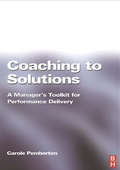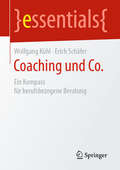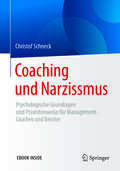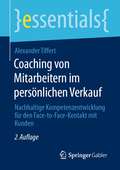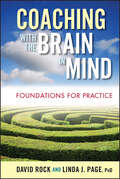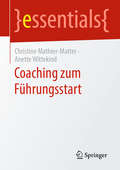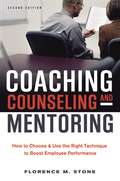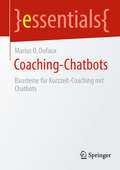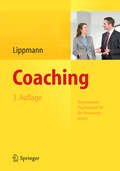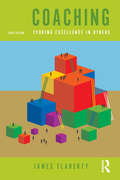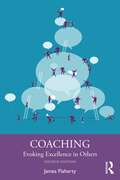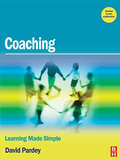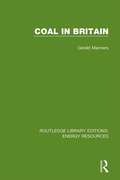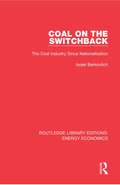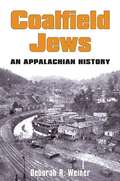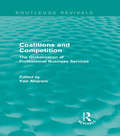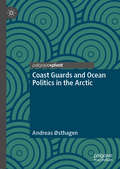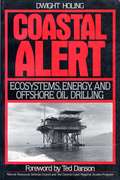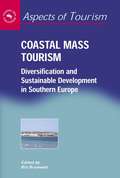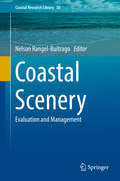- Table View
- List View
Coaching to Solutions: A Manager's Toolkit For Performance Delivery
by Carole PembertonThe book provides a tool kit for managers tasked with raising performance and sustaining motivation. Organisations are being judged by the way in which they accommodate the needs of the individual in work and life-style terms. In this context, the ‘smart’ employer will not only be looking to develop policies that retain talent through recognising their work-life issues, they will be equipping their managers to manage that talent in ways which maximise the contribution that individual can make. The text introduces managers to techniques largely drawn from Brief Therapy (De Shazer & Berg). Brief Therapy is used in the UK, but primarily by social workers, psychologists and counsellors. It's application to work settings is now growing. The attraction of a Solution Focussed approach to coaching is that it offers pragmatic tools that help managers structure helping conversations. The book presents the principles of solution focussed thinking in a language that is readily understandable by managers, and shows how those principles can be applied to a range of issues which managers may find themselves facing as willing or enforced coaches. The book places coaching as an activity which can be done as part of the daily process of management.
Coaching und Co.: Ein Kompass für berufsbezogene Beratung (essentials)
by Erich Schäfer Wolfgang KühlIn einer Arbeitswelt, die zunehmend durch Volatilität, Unsicherheit, Komplexität und Ambiguität gekennzeichnet ist und in der Wertschätzung zu einer Voraussetzung von Wertschöpfung wird, wächst der Bedarf nach Beratung sprunghaft. Gleichzeitig differenzieren sich die Beratungsformate aus. Somit wird es für die nach einer geeigneten Beratung suchenden Fach- und Führungskräfte schwieriger, die richtige Entscheidung für sich, ihre Teams und die Organisation zu treffen. In diesem essential werden die unterschiedlichen Beratungsformate prägnant dargestellt. Im Mittelpunkt stehen dabei ihre Begriffsbestimmung und Entwicklung, ihre konzeptionellen Grundlagen sowie ihre Einsatzmöglichkeiten. Das Buch bietet eine Orientierungshilfe, um professionelle Beratung zu erkennen und qualifizierte Berater*innen zu finden.
Coaching und Narzissmus: Psychologische Grundlagen und Praxishinweise für Management-Coaches und Berater
by Christof SchneckDieses kompakte Fachbuch bietet einen #65533;berblick #65533;ber Narzissmus und narzisstische Ph#65533;nomene im Management-Umfeld und skizziert einen idealtypischen Verlauf eines Management-Coachings von narzisstischen Pers#65533;nlichkeiten. Neben psychologischem und psychodynamischem Grundwissen zum Narzissmus wird dessen Allgegenw#65533;rtigkeit im Management und deshalb auch im Coaching beschrieben. Management-Coaches finden in diesem praxisnahen Ratgeber konkrete Hinweise zu allen Phasen des Coaching-Prozesses. Ein Buch f#65533;r Management-Coaches, Trainer und Berater, aber auch f#65533;r F#65533;hrungskr#65533;fte und Projektleiter, die mit dem Ph#65533;nomen Narzissmus konfrontiert sind, beispielsweise in Person des Vorgesetzten, oder die den Mut haben, ihre eigenen narzisstischen Anteile zu reflektieren.
Coaching von Mitarbeitern im persönlichen Verkauf: Nachhaltige Kompetenzentwicklung für den Face-to-Face-Kontakt mit Kunden (essentials)
by Alexander TiffertDieses essential zeigt, wie Führungskräfte durch Coaching die individuelle Kompetenzentwicklung von Vertriebsmitarbeitern im persönlichen Verkauf stetig fördern können. Dazu werden wichtige Grundlagen des Mitarbeitercoachings dargestellt und praxiserprobte Methoden beschrieben. Das Coaching von Mitarbeitern ist eines der wirksamsten Instrumente der Mitarbeiterentwicklung und gehört zu den zentralen Aufgaben einer Führungskraft: Mitarbeiter lernen, ihre eigenen Lösungen zu finden. Damit werden sie selbständiger in der Problemlösung und agieren authentischer.
Coaching von Mitarbeitern im persönlichen Verkauf: Nachhaltige Kompetenzentwicklung für den Face-to-Face-Kontakt mit Kunden (essentials)
by Alexander TiffertDas Coaching von Mitarbeitern ist eines der wirksamsten Instrumente der Mitarbeiterentwicklung und gehört zu den zentralen Aufgaben einer Führungskraft. Dieses essential zeigt, wie Führungskräfte durch Coaching die individuelle Kompetenzentwicklung von Mitarbeitern im persönlichen Verkauf stetig fördern können und wie sie dabei genau vorgehen sollten. Dazu werden wichtige Grundlagen des Mitarbeitercoachings dargestellt und praxiserprobte Methoden beschrieben. Verkaufsmitarbeiter, die lernen ihre eigenen Lösungen zu finden, werden selbständiger in der Problemlösung und agieren authentischer.Die 2. Auflage wurde vollständig überarbeitet und um ein Kapitel über virtuelles Coaching erweitert.
Coaching with the Brain in Mind
by David Rock Linda J. PageCoaching Brain in MindFoundations for PracticeDavid Rock and Linda J. Page, PhDDiscover the science behind brain-based coachingBy understanding how the brain works, coaching professionals can better tailor their language, strategies, and goals to be in alignment with an individual's "hard-wired" way of thinking. Written by two well-known coaching professionals, David Rock and Linda Page, Coaching with the Brain in Mind presents the tools and methodologies that can be employed by novice and experienced coaches alike to create an effective-and ultimately more rewarding-relationship for both coach and client.This informative guide to the neuroscience of coaching clearly demonstrates how brain-based coaching works in practice, and how the power of the mind can be harnessed to help an individual learn and grow. Illustrated with numerous case examples and stories, this book is organized for immediate use by professionals in their client work. Coverage includes: A succinct but comprehensive overview of the major scientific and theoretical foundations for coaching and their implications for practice How the language of coaching-setting goals, making connections, becoming more aware, seeking breakthroughs, and taking action-parallels what neuroscientists tell us about how the brain operates Neuroscience as a natural platform for the ongoing development of coachingBuilding on the existing foundation of coaching by adding neuroscience as an evidence base for the profession, Coaching with the Brain in Mind shows that it is possible to become a better professional coach by understanding how the brain works. As well, the authors, through their research, present that an understanding of neuroscience research, however new and speculative, can help coaches and leaders fulfill their potential as change agents in the lives of others.
Coaching zum Führungsstart (essentials)
by Christine Mathier-Matter Anette WittekindEin Schritt auf der Karriereleiter wird zunächst positiv erlebt. Doch vieles entpuppt sich für die neue Führungskraft schnell als anspruchsvoll. Nicht gut gemeisterte Anfangssituationen in der Führung führen oft zu Problemen mit dem Team. Daher lohnt sich die Investition in eine Begleitung der neuen Führungskraft, nicht nur für diese selber, sondern für die gesamte Organisation. Der Fokus dieses essentials liegt auf dem Coaching zum Führungsstart. Coaches und Führungskräfte erhalten einen Einblick in erprobte Vorgehensweisen und eine Übersicht zu „Best Practice“, um die Führungskraft optimal auf die neue Rolle vorzubereiten. Die Theorie wird durch Fallbeispiele ergänzt.
Coaching, Counseling and Mentoring: How to Choose and Use the Right Technique to Boost Employee Performance
by Florence Stone<P>Coaching, counseling, and mentoring can dramatically improve employee productivity and satisfaction.<P> But there’s a big difference between continuously encouraging employees to do their jobs well (coaching), attempting to fix poor performance (counseling), and helping top performers excel (mentoring). <P>Unfortunately, most managers don’t truly understand how and when to do each.<P> Coaching, Counseling & Mentoring provides helpful tools like self-assessments and real-life scenarios, and gives managers specific, practical guidance on using these techniques to improve the performance of all their people.<P>This updated and revised second edition includes useful scripts for talking to employees about sensitive issues, and new material on topics including working with off-site employees, what to say when an employee denies a problem exists, whether or not to coach temps and part-timers, how to draw the line between the mentoring and supervisory role, and what to do when counseling fails.<P> This is an essential guide for managers who want to build their confidence and skill in getting the most from their people.
Coaching-Chatbots: Bausteine für Kurzzeit-Coaching mit Chatbots (essentials)
by Marius O. DufauxDer technologische Fortschritt durchdringt auch das Coaching, wo Chatbots an Bedeutung gewinnen. Dieses essential bietet eine kompakte Einführung in Coaching-Chatbots und verbindet theoretische Grundlagen mit lösungsorientiertem Kurzzeit-Coaching. Praxisnahe Erkenntnisse und ethische Aspekte stehen dabei im Vordergrund und führen zum Design eines experimentellen Coaching-Chatbots, der besonders bei jüngeren Menschen wirksam ist und zugleich Herausforderungen benennt. Als Folge wird ein potenzieller Wandel in der Coaching-Branche skizziert und Coaches ermutigt, die Technologie für ihr Geschäftsmodell zu prüfen.
Coaching: Angewandte Psychologie für die Beratungspraxis
by Eric LippmannCoaching ist in aller Munde, die Angebote sind zahlreich, der Markt ist mittlerweile von vermeintlich neuen "Tools", Techniken und Ansätzen etc. fast übersättigt und sehr unübersichtlich. Diese Buch hilft, den Überblick zu behalten. Es stellt wirklich relevante Coaching-Ansätze nach einheitlichem Raster vor: Das Wichtigste in Kürze, typische Fragestellungen, Fallbeispiele, Erfolgskriterien für Berater, Besonderheiten einzelner Zielgruppen. Es informiert über wichtige Settings im Coaching-Prozess: Einzeln, in der Gruppe, kollegial, extern oder intern, als Selbst- oder Online-Coaching. Es hilft bei der Abstimmung auf bestimmte Zielgruppen: Coaching für Führungskräfte auf allen Managementebenen, im Familienunternehmen, für Schulleiter oder Lehrer, im Personalmanagement oder in der Politik. Es gibt Tipps für unterschiedliche Anwendungsfelder: Coaching bei Veränderungsprozessen, bei Konflikten, im Rahmen der betrieblichen Bildung, im Umgang mit Medien, bei Laufbahnfragen, bei Freistellungen. Kurz: Es ist ein Standardwerk für Praktiker, geschrieben von Top-Fachleuten der Branche - nun in überarbeiteter dritter Auflage und mit neuen Kapiteln zu psychodynamischen Ansätzen, Diversity-Aspekten oder Coaching im Sport. Mit Serviceteil für Coaches und Coachees: Suche und Auswahl von Coaches, Links für Coaches zu Aus- und Weiterbildungen, Kongressen, Zeitschriften, kommentierte Literaturtipps.
Coaching: Durch systemisches Denken zu innovativer Personalentwicklung (uniscope. Publikationen der SGO Stiftung)
by Jean-Paul Thommen Wilhelm BackhausenAusgehend vom systemisch-konstruktivistischen Ansatz zeigen die Autoren, wie der Coaching-Prozess gestaltet werden kann und welche Instrumente zur effizienten und effektiven Steuerung dem Coach zur Verf#65533;gung stehen. Die dritte Auflage enth#65533;lt zahlreiche neue Fallstudien, welche die Vielfalt an Coaching-Programmen in der Praxis aufzeigen, und ber#65533;cksichtigt zus#65533;tzlich auch Non-Profit-Organisationen wie die Bundeswehr und die European Business School.
Coaching: Evoking Excellence In Others
by James FlahertyCoaching: Evoking Excellence in Others is an insightful, thought-provoking guide that dissects the art and science of coaching. Beginning with theories, concepts and models, the book moves on to consider rigorous methods of practice and self-observation in a relationship of mutual trust, respect and freedom of expression. It will probe you to rethink how you relate to your clients and your staff, how you produce long-term excellent performance in yourself and how you can become more effective in helping others to achieve their goalsThis third edition includes a new chapter on communication and a new central case study that runs throughout the book to illustrate the impact of the themes and concepts discussed in the book.Coaching, 3rd edition is a rich learning resource guide for new and experienced coaches who want to challenge their methods of partnering with clients. It is also an inspiring guide for training managers and leaders, human resource development managers and general managers who want to develop their teams.
Coaching: Evoking Excellence in Others
by James FlahertyNow in its fourth edition, the bestselling, seminal book by James Flaherty, Coaching: Evoking Excellence in Others, is an insightful, thought-provoking, pragmatic guide that dissects the art and science of coaching. This fourth edition includes two brand new chapters: the first is on finding one’s inner guidance and purpose in traversing the world of work, especially in more uncertain working environments; and the second is on the topic of somatic intelligence. As in earlier editions, this foundational book in coaching clearly presents the theories, concepts, and models, and then moves on to consider rigorous methods of practice and self-observation in a relationship of mutual trust, respect, and freedom of expression. It will probe you to rethink how you relate to your clients and your staff, how you produce long-term excellent performance in yourself, and how you can become more effective in helping others to achieve their goals. Coaching, Fourth Edition is a rich learning resource guide for new and experienced coaches who want to challenge their methods of partnering with clients. It is also an inspiring guide for training managers and leaders, human resource development managers, and general managers who want to develop their teams.
Coaching: Learning Made Simple
by David PardeyLearning Made Simple books give you skills without frills. They are matched to the main qualifications and written by experienced teachers and authors to make often tricky subjects simple to learn. Every book is designed carefully to provide bite-sized lessons matched to readers' needs.Using full colour thoughout and written by leading teachers and writers, Learning Made Simple books build on a rich legacy of over 50 years as leading publishers helping to learn new skills and develop their talents.Whether studying at college, training at work, or reading at home, aiming for a qualification or simply getting up to speed, Learning Made Simple Books will give readers the advantage of easy, well-organized training materials in a handy volume you can refer to again and again. These titles will be promoted direct to training companies and learners, and individuals will be urged to buy them not only by college lecturers but also by trainers at work. These titles will be core stock for years to come.The books are written by experienced HR trainers and will be typeset by PK McBride (an experienced teacher and author of several Learning Made Simples himself). PK McBride has a thorough understanding of the ethos of the LMSs books and his involvement will insure that all titles have a layout and style consistent with the brand.
Coal Mining Communities and Gentrification in Japan
by Tai Wei Lim Naoko Shimazaki Yoshihisa Godo Yiru LimThis book offers a multidisciplinary analysis of approach in the field of energy studies of Japan, examining post-closure coal mining towns in Japan and their gentrification. It considers the impact of closures on the agricultural industry, the re-absorption of laid off coal miners into service and industrial sectors, and the gentrification of former coal mines into agricultural farms and communities. It also considers the historical process of gentrification in terms of origins, social history, continuity/discontinuity and cooperation/resistance. The historical background of coal mine closures analyses nostalgic recollection about mine closures and Sakubei's UNESCO drawings of life in the coal mines and other cultural materials related to coal energy and the mining industry in general in Japan.
Coal and Biomass Gasification: Recent Advances and Future Challenges (Energy, Environment, and Sustainability)
by Avinash Kumar Agarwal Santanu De V. S. Moholkar Bhaskar ThalladaThis book addresses the science and technology of the gasification process and the production of electricity, synthetic fuels and other useful chemicals. Pursuing a holistic approach, it covers the fundamentals of gasification and its various applications. In addition to discussing recent advances and outlining future directions, it covers advanced topics such as underground coal gasification and chemical looping combustion, and describes the state-of-the-art experimental techniques, modeling and numerical simulations, environmentally friendly approaches, and technological challenges involved. Written in an easy-to-understand format with a comprehensive glossary and bibliography, the book offers an ideal reference guide to coal and biomass gasification for beginners, engineers and researchers involved in designing or operating gasification plants.
Coal in Britain (Routledge Library Editions: Energy Resources #Vol. 4)
by Gerald MannersOriginally published in 1981. Examining in detail the best evidence on the likely level of domestic and overseas demand for British coal over the following 20 years, this study raised questions about the declared development and investment strategy of the National Coal Board. It exposes a central dilemma facing both the management and the unions of the British coal industry consequent upon their commitment to production objectives substantially out of line with likely market opportunities. It also poses questions for government and the EEC regarding the industry's finances and market prospects. The study concludes that Britain is unlikely to need both the scale of investment proposed for the coal industry and the nuclear programme endorsed by both the government and the electricity supply industry. The author argues for a rigorous reinterpretation of the prospects and a revision of the plans of Western Europe's largest coal industry. This is a fascinating snapshot of a changing industry and is interesting to those in geography, economics and industrial management and anyone interested in energy.
Coal on the Switchback: The Coal Industry Since Nationalisation (Routledge Library Editions: Energy Economics)
by Israel BerkovitchOriginally published in 1977, this book concentrates on the period since nationalisation in the history of the coal industry. It provides not only a compact summary for those within the industry but also provides understanding of its problems and achievements for those outside it. The fluctuating world fuel situation threw the fortunes of the coal industry up and down and this book examines these changing fortunes within the context of the new challenges from North Sea oil and other newer sources of fuel.
Coalfield Jews: An Appalachian History
by Deborah R. WeinerThe stories of vibrant eastern European Jewish communities in the Appalachian coalfields Coalfield Jews explores the intersection of two simultaneous historic events: central Appalachia’s transformative coal boom (1880s-1920), and the mass migration of eastern European Jews to America. Traveling to southern West Virginia, eastern Kentucky, and southwestern Virginia to investigate the coal boom’s opportunities, some Jewish immigrants found success as retailers and established numerous small but flourishing Jewish communities. Deborah R. Weiner’s Coalfield Jews provides the first extended study of Jews in Appalachia, exploring where they settled, how they made their place within a surprisingly receptive dominant culture, how they competed with coal company stores, interacted with their non-Jewish neighbors, and maintained a strong Jewish identity deep in the heart of the Appalachian mountains. To tell this story, Weiner draws on a wide range of primary sources in social, cultural, religious, labor, economic, and regional history. She also includes moving personal statements, from oral histories as well as archival sources, to create a holistic portrayal of Jewish life that will challenge commonly held views of Appalachia as well as the American Jewish experience.
Coalitions and Competition: The Globalization of Professional Business Services (Routledge Revivals)
by Yair AharoniThis title, first published in 1993, was one of the first books to analyse the forces behind the increasing globalization of professional business services. Based on contributions from leading authorities in international business, both academics and members of organizations such as GATT and UNCTAD, it looks at the opportunities for growth, environmental and regulatory problems, and the major problems of managing the international expansion of professional firms. Crucially, it discusses such issues from the point of view of managers of such organizations, and the role of governments in negotiating multinational agreements. This highly international and timely reissue will be of interest to students of international business, as well as managers of professional business firms and policy makers involved in international trade issues.
Coast Guards and Ocean Politics in the Arctic
by Andreas ØsthagenThis book is about how coast guards are becoming states’ foremost tool to manage changes occurring in ocean politics generally, and in the Arctic specifically. It looks at states’ rights at sea, changes occurring in the Arctic region, how coast guards are handling issues arising, and how international cooperation can deal with some of the related challenges.
Coastal Alert: Energy Ecosystems And Offshore Oil Drilling
by Dwight Holing Dwight Natural Resources Defense CouncilCoastal Alert explains how citizens can protect coastal resources from the damaging effects of offshore oil drilling.
Coastal Geography in Northeast Brazil: Analyzing Maritimity in the Tropics (SpringerBriefs in Latin American Studies)
by Eustogio Wanderley Correia DantasThis book studies the transformation of modern maritimity practices in coastal areas (such as swimming, navigation and tourism) and their implications to the development of Brazilian coastal cities, with an emphasis on the Northeast part of the country. It is a reflection on coastal geography in the tropics and the contemporary valorization of coastal cities from a socioeconomic, technological and symbolical point of view. The book highlights local fluxes on a regional and local scale, showing the incorporation of beach zones to spaces which were previously associated with so called traditional coastal practices (fishing activities and as harboring points). This book is dedicated to geography researchers and students.
Coastal Mass Tourism
by Bill BramwellThis book examines the development of mass tourism in coastal regions of Southern Europe, with implications for similar regions across the world. It provides a critical assessment of two influential policies intended to promote sustainable development, these being attempts to make mass tourism resorts more sustainable, and the development of smaller-scale, `alternative' tourism products.
Coastal Scenery: Evaluation And Management (Coastal Research Library #26)
by Nelson Rangel-BuitragoThis book describes an easy to apply methodology to determine the scenic value of a coast. As one of the most critical aspects of beach user choice, the determination of coastal area scenic quality is of primordial importance. This book is, therefore, an extremely useful tool for any coastal lovers, being them users, teachers, researchers, or managers.In particular, this work is the first book to present a semi-quantitative analysis of coastal scenery based on more than 4,000 interviews about people’s desired coastal imaginary. Twenty-six parameters can be used to identify any coastal scene, which have then been sub-divided into five attribute categories, weighted and subjected to fuzzy logic mathematics to obtain a decision number (D). This number D represents the coastal scenery at that point, and Five D classes are then presented (from I-excellent, to V-poor). Heritage areas, like National Parks should lie in Class I, which infers top scenic quality.Over a time span of a decade or so, the authors of this book have assessed more than 900 global locations using the technique given in this book. One of the main aims of this method is to point out how scenic areas may be improved by judicious intervention relating to parameters, mainly anthropogenic, chosen for assessment.The content of this book opens perspectives for analysis of the potential for coastal tourism development in natural areas and for landscape quality improvement in current coastal tourist developed areas. “In a very comprehensive way, this book reviews the main concepts about coastal scenery and through the vast global work experience of the authors, presents different methodologies, as well as introducing a novel methodology, using parameter weightings and fuzzy logic mathematics.”Carlos Pereira da Silva, CICS.NOVA, Universidade Nova de Lisboa, Lisbon, Portugal “Our lives will be greatly enriched by finding beauty, but we can use help in defining the many ways beauty can be manifested. This book can help us by informing us of the ways landscapes can be viewed and described from many viewpoints to place our own understanding in better perspective.”Karl Nordstrom, Geography Department, Rutgers University, New Jersey, USA “How do we define and quantify a coast’s scenic value? This is the book. It begins by defining coastal scenery, then reviews the approaches to quantifying it, followed by a new fuzzy logic approach and examples. It finishes with a chapter on how to manage these attractive landscapes, many of which are being overrun and ruined by development. This is a must read for researchers who wish to evaluate and managers who wish to maintain this valuable yet intangible coastal resource.”Andrew Short, Coastal Studies Unit, Sydney University, Australia
